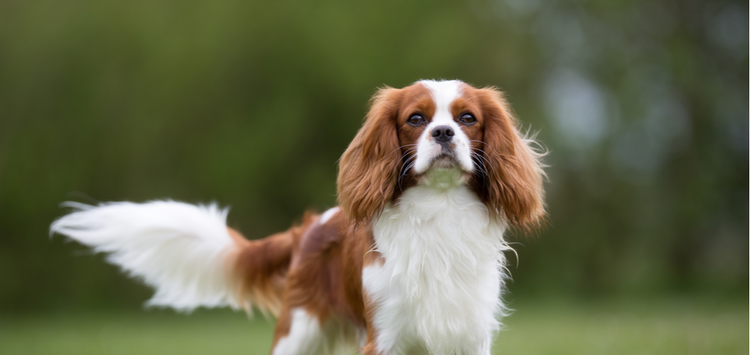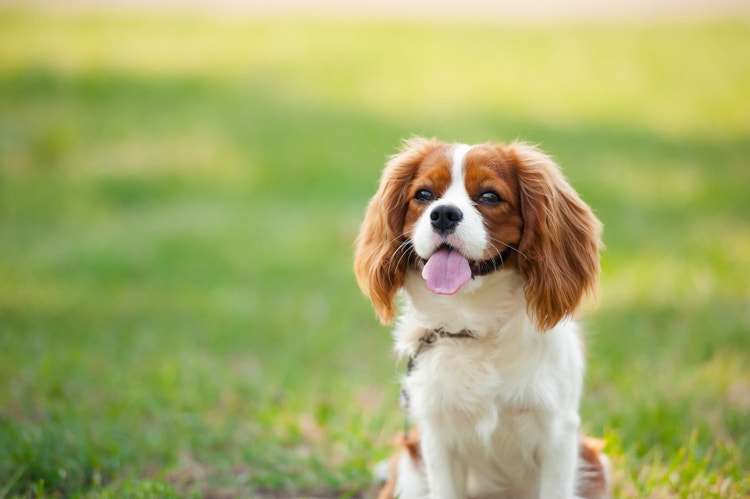

Cavalier King Charles Spaniel


Where Are Cavalier King Charles Spaniels From?
Tapestries and paintings as far back as the 1400s have depicted small, spaniel-like canines. The Cavalier King Charles Spaniel is modeled after these ancient spaniels and is thought to have originated from the larger King Charles Spaniel.
This dog was a favorite of the aristocracy, but upon the fall of the House of Stuart, the popularity of the breed rapidly declined. They were associated with luxury and wealth and seemed to have no purpose but as companions. At that time, the middle class could not afford to feed and care for a dog that didn’t work. In addition, William and Mary, rulers at that time, preferred the Pug, so association with the Cavalier King Charles Spaniel was thought by some to be a political liability.
The breed’s fortunes improved during the reign of Queen Victoria. However, during her breeding and promoting of the small spaniel, the appearance of the dog was altered. The head became more domed and the dog was eventually renamed the English Toy Spaniel. This resulted in a near extinction of the flatter-headed Cavalier. In the 1920s, in an effort to restore the breed back to its original appearance, an American named Roswell Eldridge offered a financial prize for the best dog or bitch of the “old type.” He offered this prize for 5 years.
Thanks to his offer, the breed was restored to its original form. By 1928, the Cavalier King Charles Spaniel Club was founded in England and the breed was recognized by the English Kennel Club in 1944. By the middle of the 20th century, the Cavalier King Charles Spaniel was one of the most popular breeds in England. By 1996, the Cavalier King Charles Spaniel was recognized by the American Kennel Club as a member of the Toy Group.
Caring for a Cavalier King Charles Spaniel
What Kind of Diet Does a Cavalier King Charles Spaniel Need?
What Kind of Diet Does a Cavalier King Charles Spaniel Need?
The Cavalier requires a well-balanced diet to keep them in good health. It is important to not feed a grain-free diet, as this could contribute to heart disease. This is a breed that is prone to obesity, so it is important that you monitor caloric intake. You should consult with your veterinarian to help develop an appropriate meal plan.
How Much Grooming Does a Cavalier King Charles Spaniel Need?
How Much Grooming Does a Cavalier King Charles Spaniel Need?
The Cavalier only requires weekly brushing to prevent matting and knotting of the hair coat, especially around the ears, legs, and tail. Bathing once a month is enough to maintain happiness and health. Dental disease is common for the breed, so it is important to brush weekly to prevent tartar buildup.
Are Cavalier King Charles Spaniels Healthy Dogs?
Are Cavalier King Charles Spaniels Healthy Dogs?
The Cavalier is a relatively healthy breed that has an average life span of about 12 years. They are predisposed to developing heart abnormalities as young adults and should be seen by a veterinary yearly to screen for heart diseases. They should also be screened for ocular diseases, orthopedic conditions, and diabetes at a young age. As veterinary care can be quite expensive for pets in need of a specialist, like a cardiologist, it is best to get pet insurance as early as possible for this breed.
The breed is predisposed to: chronic valvular disease, patent ductus arteriosus, patellar luxation, hypothyroidism, brachycephalic syndrome, allergies, deafness, entropion, distichiasis, keratoconjunctivitis sicca, corneal dystrophy, epilepsy, cataracts, progressive retinal atrophy, hip dysplasia, cryptorchidism, and diabetes.
How Much Training Does a Cavalier King Charles Spaniel Need?
How Much Training Does a Cavalier King Charles Spaniel Need?
Cavaliers are an extremely intelligent breed that is eager to please, which makes training a pleasure for owner and dog alike. They can be trained in agility and hunting, along with basic commands. Early socialization and obedience training should be started between 8 and 12 weeks of age to ensure they develop into a well-behaved members of the family.
How Much Exercise Does a Cavalier King Charles Spaniel Need?
How Much Exercise Does a Cavalier King Charles Spaniel Need?
Cavalier King Charles Spaniels require daily exercise. They love to play fetch, since they were bred to retrieve. They also love to swim, which is a great exercise activity for the breed. They thrive off of human contact and love to accompany their owners on daily walks. They require about 1 hour of activity per day to keep them healthy.
What Are the Physical Characteristics of a Cavalier King Charles Spaniel?
Cavalier King Charles Spaniel Facts
Other Breeds to Explore
References
- Morris, Desmond. Dogs: The Ultimate Dictionary of Over 1,000 Dog Breeds. Trafalgar Square, 2002.
- American Kennel Club. The Complete Dog Book. Random House Digital, Inc., 2006.
- Wilcox, Bonnie and Chris Walkowicz. The Atlas of Dog Breeds of the World. T.F.H Publications, Inc., 1995.
- Shops centre ban for ‘royal’ dog. Manchester Evening News, 2013.


